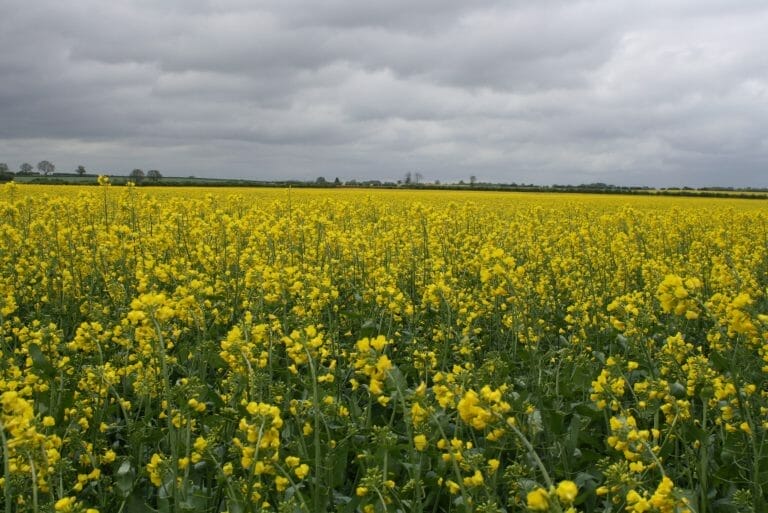
Jonathan Payne, Nickerson Seed Specialist
Jonathan Payne of Nickerson Seeds points out it is crucial to consider the individual merits of each particular variety to suit a particular situation as this will help maximise the crop’s genetics and achieve the best results.
“When choosing a variety it is crucial to consider the individual merits of each particular variety to suit a particular situation to then maximise the crop’s genetics to achieve the best results.”
For example, he points out that Turnip Yellows Virus (TuYV) is becoming increasingly challenging to control, as the main vector; the peach potato aphid (Myzus persicae), has developed resistance to pyrethroids, and the disease becomes more widespread across the British isles.
Since 2016, Limagrain UK along with industry partners – Agrii, Openfield and the AICC – have been monitoring levels of TuYV in crops across the UK.
Sampling is carried out twice during the growing season, with an initial small-scale survey conducted in Oct-Nov, followed by extensive testing carried out in early spring.

Picture shows TuYV affecting a crop of oilseed rape
“TuYV incidence reached its highest level ever last season, with 84% of non-TuYV resistant UK crops infected in early spring 2019. Almost all sites had an infection rate between 81-100%”, explains Dr Vasilis Gegas, Limagrain’s European oilseed rape portfolio manager.
“Whilst incidence was highest in East Anglia and south east England, sites in Scotland and the South West now also show very high levels of infection.”
“Four years ago we wouldn’t have seen high levels in the North. But last year we saw 70-75% infection of OSR in Perth and 50-54% in Aberdeen,” he points out.
“Infection usually occurs in Sept to Oct when aphids are still flying – the earlier a crop is infected, the less seeds per pod develop, so the harsher the yield penalty”, he adds.
“This means that early drilled crops that are more open, corresponding with mild autumnal conditions, are at the highest risk. Once an aphid picks up the virus, it’s infected for life – if an uninfected aphid feeds on an infected plant, the aphid becomes infected and so the cycle continues.”

Dr Vasilis Gegas, European Oilseed Rape Portfolio Manager
Limagrain was the first to introduce a commercially available TuYV resistant variety back in 2014, Amalie.
However, the variety was lower yielding than others and was recommended as a special category.
Over the past few years, there’s been a huge genetic improvement in breeding for TuYV resistance, meaning that Limagrain’s TuYV resistant varieties have moved from the bottom of the yield pile to the top by quite a margin – and today, TuYV resistant varieties sit amongst the highest yielding varieties on the 2020-2021 AHDB Recommended List.
“Yielding 106% over control, Aspire is one of these varieties, and the only conventional variety on the RL that carries the TuYV resistant gene”, says William Charlton, Limagrain’s UK arable marketing manager.
Aspire has been very successful in both official and on-farm trials, and when it was recommended, it was the highest yielding OSR variety on the RL, he adds.
“Year-on-year it’s proved to be a very robust variety across the board which has attracted growers and Aspire often sells itself through its performance in on-farm trials.”
Last year’s harvest results from trials conducted by the AICC in West Wittering, Sussex, showed that there was at least a 0.4-0.5t/ha yield advantage from varieties with TuYV resistance against those without.

William Charlton, Arable Marketing Manager
“Aspire particularly stood out in this trial, yielding 6.7t/ha – that’s a massive bonus over the 6.1t/ha from Django or 6t/ha from Campus,” explains Peter Cowlrick, AICC. “In a second trial in West Sussex, the trend was the same, with TuYV-resistant varieties leading the pack.”
While growers often associate hybrid types for their high yield potential, Aspire balances performance with some of the easier management aspects that conventional varieties glean, adds Will.
“Hybrids are normally the focus for breeders and growers, but we wanted to provide this level of performance for growers who prefer to grow conventional OSR”.
And it’s not just a top performer in terms of TuYV. Aspire also scores a 7 for light leaf spot, and 6 for stem canker.
“It’s probably the cleanest conventional variety I’ve ever seen,” adds Jonathan Payne.
“Aspire is short and stiff-stemmed and therefore easier to manage which we know is one of the key reasons growers opt for conventional varieties.”
Also positioning it as better suited to early drilling, Jonathan reckons a lot of growers will be looking to target that initial sowing window this coming season. “I think this year growers will be looking back over the past few years and will see the early drilling slot is often the go-to, to avoid catchy weather patterns, and Aspire’s TuYV trait will be crucial when aphid pressure is higher.”

































